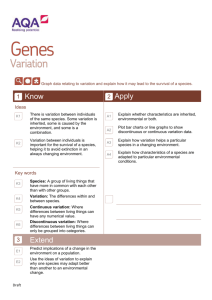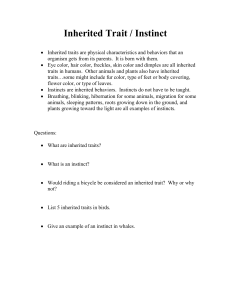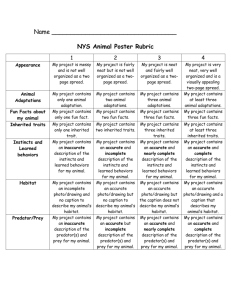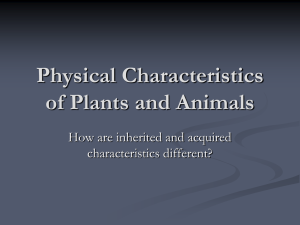4-2.4 - S2TEM Centers SC
advertisement
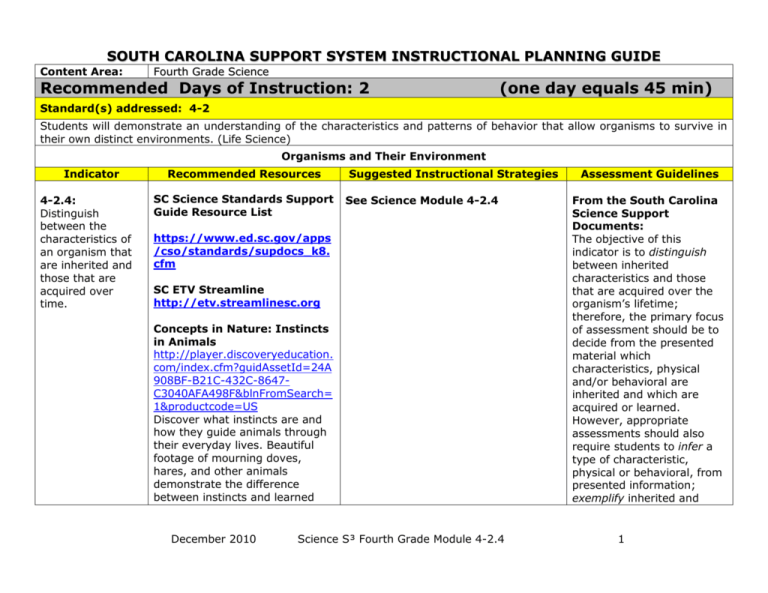
SOUTH CAROLINA SUPPORT SYSTEM INSTRUCTIONAL PLANNING GUIDE Content Area: Fourth Grade Science Recommended Days of Instruction: 2 (one day equals 45 min) Standard(s) addressed: 4-2 Students will demonstrate an understanding of the characteristics and patterns of behavior that allow organisms to survive in their own distinct environments. (Life Science) Organisms and Their Environment Indicator 4-2.4: Distinguish between the characteristics of an organism that are inherited and those that are acquired over time. Recommended Resources SC Science Standards Support Guide Resource List Suggested Instructional Strategies See Science Module 4-2.4 https://www.ed.sc.gov/apps /cso/standards/supdocs_k8. cfm SC ETV Streamline http://etv.streamlinesc.org Concepts in Nature: Instincts in Animals http://player.discoveryeducation. com/index.cfm?guidAssetId=24A 908BF-B21C-432C-8647C3040AFA498F&blnFromSearch= 1&productcode=US Discover what instincts are and how they guide animals through their everyday lives. Beautiful footage of mourning doves, hares, and other animals demonstrate the difference between instincts and learned December 2010 Science S³ Fourth Grade Module 4-2.4 Assessment Guidelines From the South Carolina Science Support Documents: The objective of this indicator is to distinguish between inherited characteristics and those that are acquired over the organism’s lifetime; therefore, the primary focus of assessment should be to decide from the presented material which characteristics, physical and/or behavioral are inherited and which are acquired or learned. However, appropriate assessments should also require students to infer a type of characteristic, physical or behavioral, from presented information; exemplify inherited and 1 behavior. Students learn that from migration to hunting for food, instincts help animals survive. New Hampshire Public Television http://www.nhptv.org/naturewor ks/nwep4.htm Students are able to investigate migration (some animals move to find food and stay warm); how and why animals migrate including quizzing themselves on what they know. December 2010 Science S³ Fourth Grade Module 4-2.4 acquired physical or behavioral characteristics; or identify the physical or behavioral characteristic as inherited and acquired based on its description. 2 Fourth Grade Science Module 4-2.4 Organisms and Their Environment Lesson A Standard 4-2: Students will demonstrate an understanding of the characteristics and patterns of behavior that allow organisms to survive in their own distinct environments. (Life Science) Indicator 4-2.4: Distinguish between the characteristics of an organism that are inherited and those that are acquired over time. December 2010 Science S³ Fourth Grade Module 4-2.4 3 From the South Carolina Science Support Documents: Indicator 4.2.4: Distinguish between the characteristics of an organism that are inherited and those that are acquired over time. Taxonomy level: Analyze Conceptual Knowledge (4-1.B) Previous/Future knowledge: In kindergarten (K-2.3), students learned that animals and plants look like their parents. In 3rd grade (3-2.2), students explained how physical and behavioral adaptations allow an organism to survive. Students have not previously identified characteristics as inherited or learned over time. This concept will be further developed in 6th grade when students explain how plants respond to external stimuli (dormancy and tropisms) (6-2.8) and compare learned and inherited behaviors in animals (6-3.7). In 7th grade (7-2.7), students will distinguish between inherited traits and those acquired from environmental factors. It is essential for students to know that some characteristics that organisms have are inherited (come from their parents) and some can be acquired over the lifetime of that organism. These characteristics may be physical or behavioral. Physical Characteristics Some physical characteristics of organisms are passed from parents to their offspring (inherited). Some examples of animal characteristics may be type and color of body coloring, type and shape of sensory organ, or body structure. Some examples of plant characteristics may be type of leaf, color of flowers, or type of fruit. Some physical characteristics of organisms change over the life of the organism. Some examples of animal characteristics may be weight, hair length, or changes due to injury. Some examples of plant characteristics may be number of leaves, length of roots, or amount of branching. Behavioral Characteristics A behavior is a response to a change in the environment. Both plants and animals respond to their environment. Plants respond to light, water, gravity, and touch. Some examples of ways in which plants respond to their environment may be: Their roots grow down, while stems grow up. Vines will grow up a support; or some leaves close up when touched. Leaves grow toward the light. Animals are born with certain behaviors that allow them to survive. In animals, these behaviors are called instincts. Some examples of animal instincts may be A duck knowing how to swim across the lake without being taught. Different birds build different types of nests without being taught how. Migration and hibernation are also instincts. December 2010 Science S³ Fourth Grade Module 4-2.4 4 Animals can also acquire behavioral characteristics as they grow and develop. These characteristics are usually in response to environmental conditions and are a result of learning. Learning is a change of behavior resulting from specific experiences. Unlike instinctive behaviors, learned behaviors are shaped by experience. Some examples of learned behaviors may be: o A dog can learn to roll over on command. o A baby bird is taught to fly by its parent. o A bear learns to fish for food. It is not essential for students to summarize how these behaviors influence the survival of an organism. Students do not need to identify specific tropisms or dormancy in plants. Assessment Guidelines: The objective of this indicator is to distinguish between inherited characteristics and those that are acquired over the organism’s lifetime; therefore, the primary focus of assessment should be to decide from the presented material which characteristics, physical and/or behavioral are inherited and which are acquired or learned. However, appropriate assessments should also require students to infer a type of characteristic, physical or behavioral, from presented information; exemplify inherited and acquired physical or behavioral characteristics; or identify the physical or behavioral characteristic as inherited and acquired based on its description. December 2010 Science S³ Fourth Grade Module 4-2.4 5 Teaching Indicator 4-2.4: Lesson A – “Inherited and Acquired Characteristics” Instructional Considerations: This lesson is an example of how a teacher might address the intent of this indicator. It is adapted from the Anderson School District Five Curriculum. The STC Animals kit provides an opportunity for conceptual development of the concepts within the standard. Make copies of the Behavior cards and cut them into strips or cards. Make enough so that each pair or students have a set of these. Misconceptions: By the end of 2nd grade, students know that children resemble their parents and realize that reproduction underlies this resemblance. Students at this age can also begin to understand the difference between learned characteristics and inherited characteristics. The idea that some behaviors are actually inherited is a hard concept for students to grasp. It’s easy when discussing barking dogs or purring cats, but when you try to tell them that some of their actions are instincts, they have a hard time discerning those from learned behaviors. Safety Note(s): Safety must be emphasized at the beginning of the school year and reinforced with every lab activity. Students should understand that safety is everyone’s responsibility. Lesson time: 2 day (1 day equals 45 minutes) Materials Needed: A set of Behavior cards for each pair of students Focus Question: What is the difference between inherited and acquired characteristics? Engage: Ask the following questions: Who do you look like? Do you look like your mother, father, aunt, uncle? What makes you look like them? (hair color, eye color, dimple in chin, etc.) (These are physical characteristics that are inherited traits, characteristics we are born with.) Do animals resemble their parents? How? Behavior is how animals respond to their surroundings (environment). Some behavior is learned, and some behaviors are instincts. Instincts are behaviors that animals are born with. Ask students to raise their hand if they have a pet. If December 2010 Science S³ Fourth Grade Module 4-2.4 6 they do, have them describe some funny things they do. As they tell their behaviors, ask them to decide if it is something their pet has learned (playing dead, rolling over, coming to their food dish at the sound of a rustling bag) or if it is something instinctive to their species (barking at cats, playing with their tails, pouncing). Tell them that these are obvious behaviors. Can tell if they are learned from their surroundings or if they would act that way no matter where they were? Give examples (see the support document) or show the SC ETV Streamline clip Concepts in Nature: Instincts in Animals (See resource list) and have students identify examples. Write examples on the board or chart paper. Explore: Have students work in pairs. Give each pair a set of Behavior cards. Use the Behavior cards to sort into inherited characteristics (inherited behaviors) and acquired characteristics (learned behaviors). Explain: The physical qualities of plants and animals are inherited from parents (e.g. size, color, shapes of flowers; appearance, strength, intelligence of animals.) An instinct is a behavior that an animal is born with (e.g. hibernating, migrating, nest-building, caring for young.) A learned behavior is one that an animal develops by watching or hearing other animals. Make a T chart with Instincts (Inherited Behaviors) and Learned Behavior. Have students share how they sorted the Behavior Cards. Have them add other examples. Extend: Create a list of 20 of your own behaviors throughout the day, such as waking up, brushing your teeth, walking, eating, or reading. Which of these are learned and which are instinctual? If they were learned, how did you learn them? Explain the various ways in which learned behaviors can be learned. For example, how did you learn to tie your shoes? How did you learn that it's best keep your eyes closed when you're washing shampoo out of your hair? Brainstorm other examples to discuss. December 2010 Science S³ Fourth Grade Module 4-2.4 7 Name: __________________________________ Date:______________________ Writing in Science: Instincts vs. Learned Behavior 1. Animals are born with certain behaviors that allow them to survive. In animals, these behaviors are called instincts. What have you learned about instincts and provide examples? 2. A behavior is a response to a change in the environment. What is a learned behavior and provide examples? 3. What was the most interesting thing you learned? December 2010 Science S³ Fourth Grade Module 4-2.4 8 Behavior Cards A hummingbird drinking nectar from a flower A horse carrying a rider on its back A honeybee building a honey comb A lizard warming itself in the sun A dog standing on its hind legs begging for a treat A dog barking at a stranger An elephant holding one leg up for a trainer An elephant sucking water into its trunk A child raising his hand to speak A child jerking his hand away from a hot stove A camel kneeling on the ground so a rider can climb on A baby camel turning to its mother for milk A bird building a nest in a hollow place in a tree A bird saying human words A monkey swinging from branch to branch so it doesn’t have to touch the jungle floor December 2010 Science S³ Fourth Grade Module 4-2.4 9 A monkey giving a human a “high five” A horse stopping when it hears the rider say, “Whoa!” A python strangling its prey before it swallows it whole A python allowing its handler to put it around his neck A mouse pushing a button to have its food released from a container A mouse finding a crumb of food from a distance away A baby crying when it wants to be picked up An adult sneezing when there is pollen in the air An adult shaking hands to greet someone A spider spinning its web Woodchucks and bats hibernating during the winter Salmon migrating upstream to lay eggs December 2010 Science S³ Fourth Grade Module 4-2.4 10

